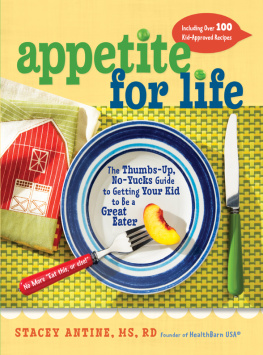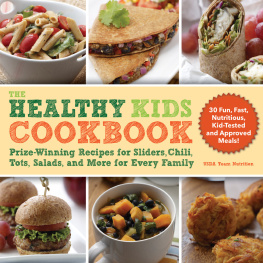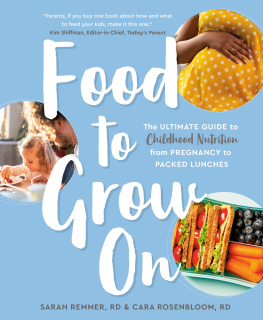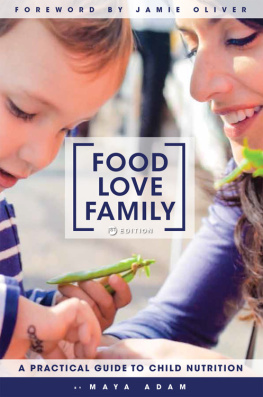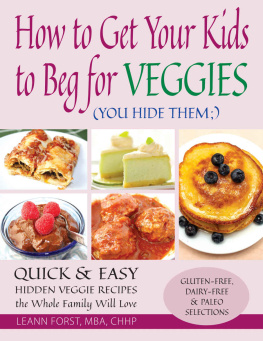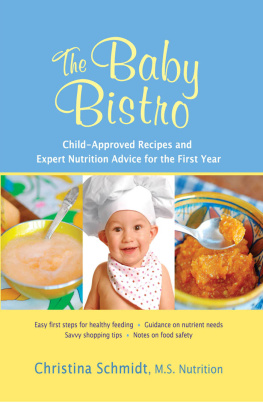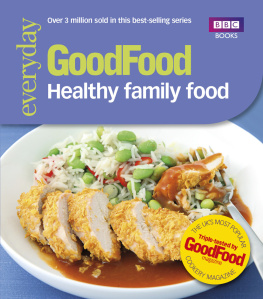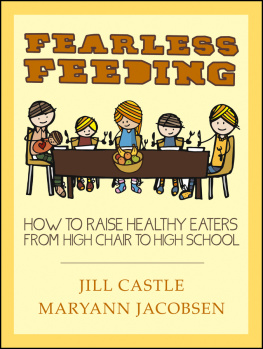
To the HealthBarn USA kids, who have
proven that kids will eat healthy foods;
and to their parents, who have
braved the healthy lifestyle frontier.
May you continue to inspire me and
motivate others to live the healthy way.
contents

Come Eat at Our Table
She wont eat it, Kim said to me as we walked through the organic garden. The garden was at its summer peak and bursting with a bounty of ripe tomatoes, crisp bell peppers, several varieties of beans, tender salad greens, herbs, berries, and other edible delights. The it in question was just-picked Swiss chard, which Kim was sure that her daughter would reject. She described her daughter and son as picky eaters who would not eat green food.
Shes not going to touch it, Kim said with conviction as we harvested the produce and moved into the barn to make pizzas, rolling out whole-grain crusts and topping them with natural tomato sauce, herbs, cheese, and lots of veggiesincluding Swiss chard. We had instructed the kids to make their individual pizzas as colorful as possible with the fresh vegetable toppings, but Kim was so focused on her finicky daughter that she allowed her to make a plain pizza with just sauce and cheese, but no green herbs or veggies. Meanwhile her son, who Kim had left alone during the class, had dutifully followed the instructions and like all the other kids was busily piling his creation high with toppings, including Swiss chard.
Shes going to hate it, Kim said, shaking her head and hovering over her daughter as the delicious-smelling, kid-created pizzas began to come off the grill and the kids gathered hungrily at the table to sample their savory creations.
As Kim predicted, her daughter ate a plain slice and wouldnt try a bite with the dreaded green. Meanwhile her son sat down at his place and, like his classmates, quietly began devouring every bite of his pizza, Swiss chard and all. When she finally left her daughter and went to check on her son, Kim was totally amazed. Swiss chardhe ate Swiss chard!
Real Food, Good FoodIts Not Just for Grown-Ups!
Kim was astonished that her child ate healthy foodgreen food, at that. I, however, am anything but surprised when I see kids thoroughly enjoy delicious, fresh, whole foodsvegetables, fruits, whole grains, lean protein, and more. This is just one of many turnarounds Ive witnessed at HealthBarn USA.
I founded HealthBarn USA in 2005 on the grounds of Abmas Farm in Bergen County, New Jersey, just outside New York City. We sprouted another location in 2011 at Hilltop Hanover Farm and Environmental Center in Westchester, New York. Part working farm, part classroom, HealthBarn USA has shown thousands of kids and parents how to live and eat healthfully from nature through our on-site programs and outreach into schools and communities. In fact, Ive seen countless kids do an about-face on things like icky vegetables and weird foods, often to the utter disbelief of grown-ups and parents like Kim.
Why wouldnt kids like to eat pure food from nature? Children arent born hating green vegetables and loathing fresh fruit. Babies dont toddle into the grocery store on their own and exit with salty chips, greasy donuts, and sugary soda any more than they crawl into the kitchen and microwave a frozen burrito. We strive to teach our children the best life lessons, but based on what Ive observed as a longtime proponent of healthy-lifestyle education for families, even the best parents are often passing along a bias against healthy foods via an assumption that kids just wont like them.
As adults, we may be concerned that childrens palates cant handle the grown-up flavors of vegetables like brussels sprouts and kale (which seem to put off a lot of adults too), whole grains like quinoa, fish like salmon, or even dark chocolate. Or, perhaps as babies they start out eating everything put in front of them (including the Swiss chard) but when they hit toddlerhood and preschool they begin rejecting what they once enjoyed and adamantly refuse new foods. (Some evolutionary biologists say this narrowing of tastes among children is not uncommon, as it reflects an instinctively cautious approach to food. To survive, humans had to learn what was safe to eat and what would kill them. When babies learn to walk and eventually explore their worldno longer protected by their mothersthey naturally become more careful.)
The littlest eaters, searching for some control over their world, quickly learn the word no! and the art of flinging unwanted food, even if you lovingly made it from scratch. Then they learn to speak in complete sentences, including, Yuck, what is that? and Ill only eat white food. What parent doesnt get tired of playing enforcer (Eat your peas!) or detective (Why arent you eating that chicken? Does it need salt? Is it too spicy?) or martyr (I made this just for you and you wont eat it!) at the dinner table. The angry scraping of leftovers into the trash typically follows.
Nourishment from Nature
Throughout this book, youll see the phrase foods from natureand that is exactly what I mean. Im not talking about processed, packaged, boxed foods that say all-natural on the front of the box. Thats merely marketing, not fact. The label all-natural, unlike organic, is not strictly regulated by the FDA, and it can be applied to many processed foods. (Manufacturers of foods with dyes and additives will argue that their foods are all-natural because ingredients like high-fructose corn syrup, for example, come from corn.) Instead, Im talking about pure food, made from unadulterated ingredients direct from naturefood straight from the ground, from the farm, from the garden, but not from the factory. Foods from nature are what we eat at HealthBarn USA, and theyre what your family can begin to eat, starting now.
Worn-down parents, even those with healthy, varied diets, begin to wonder why they should bother serving their children the good stuffreal food, good foodif it always gets rejected. Were surrounded by heavily advertised convenience foods that were led to believe all children love and are a snap for busy parents to put on a plate: frozen chicken nuggets shaped like dinosaurs, microwavable mac and cheese, yogurt in neon colors not found in nature, juice drinks that come in boxes and pouches, fast-food kiddie meals served with a toy, and so much more. Why not take the path of least resistance and bring peace (forget the peas) to the table? Why not just give up and give in to what he or she will eat?
We Can Make It BetterHeres How
Beyond the fact that as the parent youre in charge of the food (for now), by feeding your kids the healthy way you are giving them the gift of good healthhelping them to make wise choices while they are young.
A childs diet and lifestyle will impact the quality of her life in adulthood, for better or for worse. When I was studying nutrition, the words of a well-known public health advocate shocked and saddened me. We may be raising the first generation born after World War II whose lifespan may decrease, says Joanne Ikeda, because of a lifestyle that puts its members at high risk of chronic disease.
I vividly remember sitting in class, reading those words, and being stunned. Kids today might not live as long as their parents or grandparents? How could this be? We have made amazing strides in preventive medicine, havent we? Living conditions around the globe are certainly better than they were fifty years ago. Todays children have so many advantagesbut they also have a less active lifestyle and regularly consume foods that are more artificial than natural. Therefore, lifestyle diseases like obesity, heart disease, and diabetes are laying claim to younger and younger children. The list of weight- and diet-related problems that adults and increasing numbers of young children are facing today is endless and sobering, not to mention the low self-esteem and depression that accompany these physical ailments.
Next page
